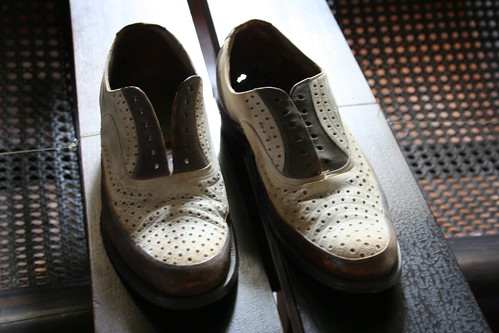 Ang Tibay`s Branches in Manila (Map from Dimasalang Kalendaryong Tagalog)
Ang Tibay`s Branches in Manila (Map from Dimasalang Kalendaryong Tagalog)ANG TIBAY. Ang mapaggawa ng mga sinelas, kotso, zapatilya at sapatos na pang BAGONG TAON at Pangmatagalang Panahón. (We make shoes for the new year that will practically last forever!)
ANG TIBAY. Ang iginaganda ng mga sinelas, kotso, zapatilya at sapatos na gawa sa Pagawaáng ito, pagka't mga sunod sa USO at MODA na sadyang pang mahal na Araw. (We have up-to-date styles, look your best on your special days!)
ANG TIBAY. Ang Sinelasan at sapatusan, gumagawa ng mga sinelas, kotso, zapatilya at sapatos na malamig sa paa, lalo na sa ganitong taginit. (We make shoes that are cool on the feet specially in this heat!)
ANG TIBAY. Ang mga sinelas, kotso, zapatilya at sapatos sa pagawaang ito, ay siyang mainam na pang Antipolo, pagka't magagara, panbundok at panlaban sa lupang malagkit. (We make shoes that are best for going up Antipolo - stylish, mountain-bred, built for muddy terrain!)
ANG TIBAY. Ang unang Sinelasan at Sapatusang pinarisan ng iba sa nagkukumpuni kung nasira ang kanyang mga yari, na walang bayad kailan ma't maaaring kumpunihin pa. (As long as your shoes are still repairable, we'll mend them for free!)

Emilio Aguinaldo's Ang Tibay Shoes on display at Kawit Cavite
ANG TIBAY. Ang tanging Sinelasan at Sapatusan na naglilinkod at dumadayo sa bahay ng nagpapagawa, (sa Maynila lamang) kailan ma't tawagin sa telepono ó sa sulat upang sukatan ang kanilang mga paa. (We measure your shoe-size right in your living room!)
ANG TIBAY. Magpahanda na kayo ng inyong sinelas, kotso, sapatilya sapatos ó botitos na pamasko na makakabagay ng bago ninyong terno ó trahe. (We make shoes that will best match your wardrobe!)
This series of ANG TIBAY ads appeared in Honorio Lopez' Dimasalang Kalendariong Tagalog in 1922. Sorry for the translations, sometimes I get a bit carried away.


